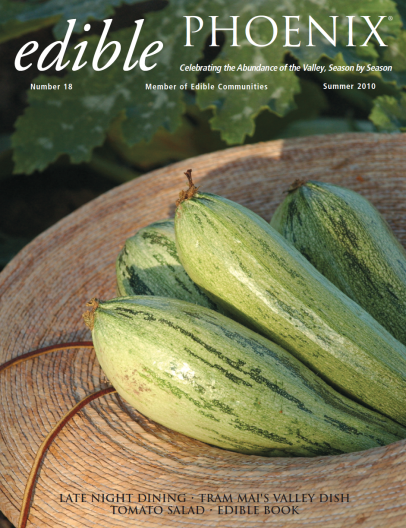Local Flavor, Letter from the Publisher
I just made my travel plans for the biennial Salone del Gusto (Salon of Taste) this coming October in Turin, Italy, sponsored by Slow Food. This will be my third trip and I’m very much looking forward to sampling the wares of food and beverage artisans from around the world. For although I am an ardent supporter of all things local, as you well know, I also have a deep appreciation for the efforts of these master farmers, bakers, vintners, cheese makers and more.
Contrary to the opinion of some, being a locavore does not mean eschewing all food products from outside of a local region. To me, it’s always been about what makes sense. If a tomato is in season locally, will it be my first choice? Of course. But when our local crop has been exhausted and fine organic heirloom tomatoes are available from California, I won’t say no either.
I had a dinner conversation not too long ago with a recent transplant to Arizona who was curious as to what food plants might be hardy enough to survive the Valley’s brutal summers. I mentioned the usual basil, melons, Armenian cucumbers and others but also said that it was OK with me that our summer crops were a bit limited. For unlike the rest of the country, our “down time” coincides with the summer “boom time” in cooler parts of Arizona and in our neighboring states, and I am willing to take advantage of their seasonal bounty.
I am also a big believer in tradition and terroir. Some foods just belong to a certain people or geography. In Europe, this is formally recognized and sanctioned. For example, you can only make Parmigiano-Reggiano (Parmesan cheese) in a limited area of Italy using specific techniques and aging times. The many years of cheese-making tradition combined with the cows’ local diet results in a distinctive product. But when you take the production one step further and use only the milk from the traditional but endangered vache rosse, or red cows, and you age it for over three years, you have a masterpiece of a cheese that commands a high price commensurate with its uniqueness.
So when Chef Claudio from the Prado restaurant at the Montelucia Resort offers me precious shards of the Vache Rosse Parmigiano, I am going to say yes. And I’m going to applaud Claudio’s purchase for helping to bring red cows back from the brink of extinction.
But when I’m looking for a soft goat cheese, I’m not going to seek the chevre of France. I’m going to turn to our Arizona goat cheese makers and the flavors of Arizona that they bring to their product. Some foods just taste better when they are freshly made and consumed close to their source. Whether it’s bagels in New York, croissants in Paris or pita breads baked over an open flame in the Arabian Desert, there are foods that just must be eaten in their home environment to be fully appreciated; the atmosphere is as much a part of the food as the ingredients it is made of.
And the final reason that I’m going to enjoy sampling the artisan food and beverages of the Salone del Gusto is talking with the artisans themselves. Reading the stories behind the farmers, fishers and producers featured in the new book Edible: A Celebration of Local Foods reminded me once again that you can taste the hard work, passion and dedication of the makers in every bite of amazing artisan food from the humblest bean to the most exquisite restaurant meal.





